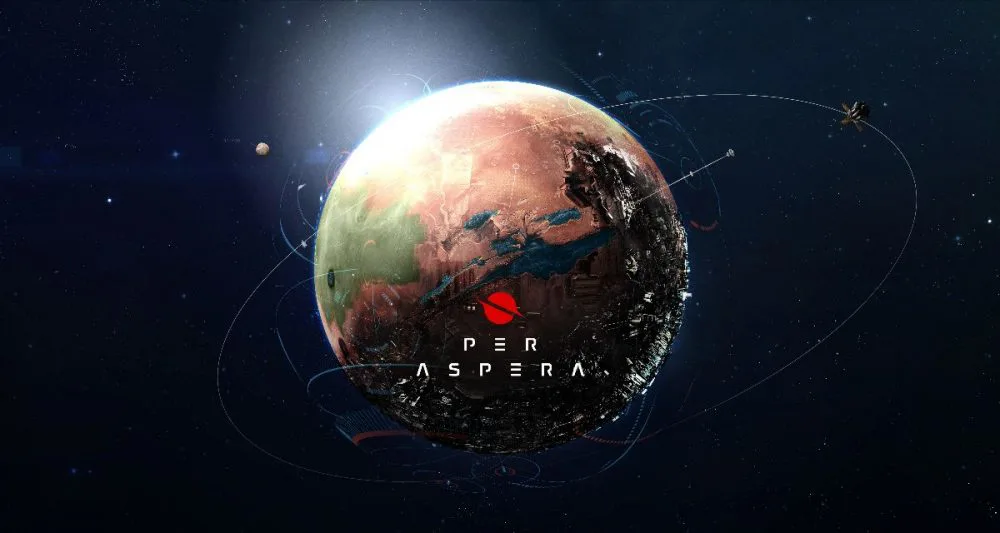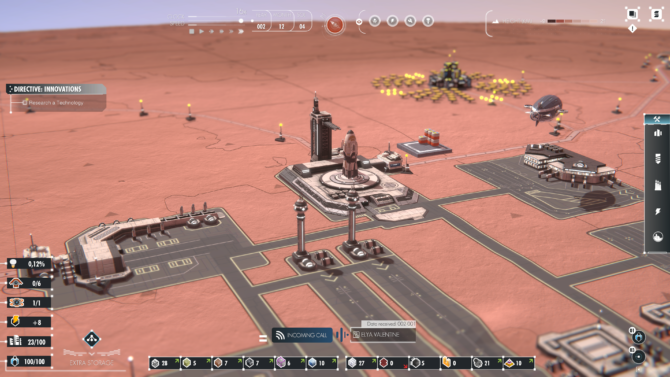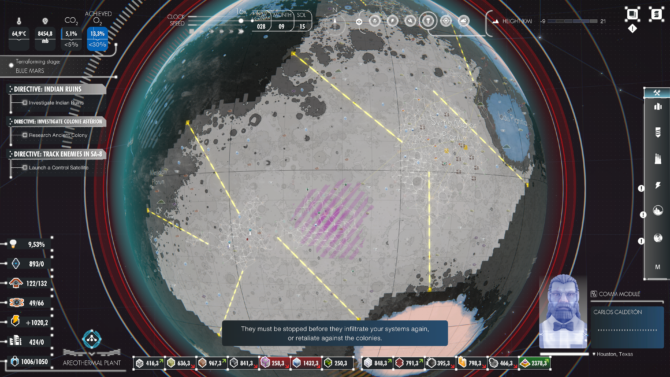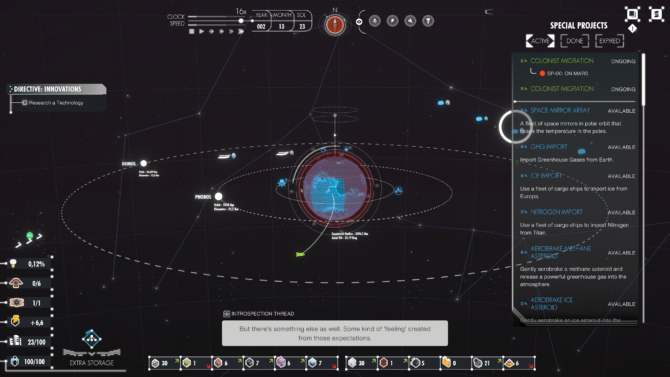Per Aspera is a planetary simulation title that takes place in a surprisingly underused setting: far future planet terraforming. The game uses an initially straightforward premise: AMI, an advanced AI system, is spearheading a project that seeks to transform Mars into a suitably habitable planet for humanity. It's up to the players to incarnate AMI and fulfill that role.
Though many of the core mechanics should be familiar to fans of the genre (such as gathering and managing resources, territory expansion by constructing new plants and other places of interest, keeping the people inhabiting the colony satisfied, etc), the aesthetics and execution of this game are completely unique.
[pullquote]The main goal of Per Aspera is maintaining a balance between mining, construction, expansion, maintenance, and keeping the humans living on the base happy. [/pullquote]
Upon first landing on Mars, you’re tasked with setting up a base of operations as well as a mine and a factory. Mines are used to gather raw materials on the planet, which are then sent to the factories that refine said raw materials into building components. These components are vital to create structures that are needed to expand territory, create and repair maintenance workers, produce resources to keep the human occupants healthy and happy, and keep power running throughout all the structures. Needless to say, mines have finite materials, so keeping track of when they run out is vital, as you’ll need to scrap the mine to avoid wasting power that could go to other structures. All while having another mine ready to be exploited as a replacement, to avoid a deficit of that particular resource. Workers and maintenance drones also break down after a while so another vital task is making sure there’s a factory as well as ample supplies ready in order to build new ones when needed.
The main goal of Per Aspera is maintaining a balance between mining, construction, expansion, maintenance, and keeping the humans living on the base happy. Players need to constantly monitor both the condition of the various structures and perform needed maintenance on them by using the Lenses mechanic. Completing the mission objectives are also vital, as well as managing the fallout from various hazards that are scattered around Mars.
[pullquote]Over time, players will become far more adjusted to the system and it becomes second nature balancing the many tasks while using the pause button less frequently.[/pullquote]
Initially players will be learning how to play Per Aspera on their own, as there are no tutorials on interpreting the user interface and none on the actual controls or how to manage buildings and resources. As daunting and complex as the game can feel when you first start, the lack of help is solely mitigated by the pause button. You can pause the continuously running game and use the break to become more acclimated to the UI and controls, read over any documents, and take care of any other pertinent tasks. Then, you resume time, monitor the base until constructions are complete, re-pause, and rinse and repeat. Over time, players will become far more adjusted to the system and it becomes second nature balancing the many tasks while using the pause button less frequently.
While other simulation games are often focused on creating a clean layout that is both organized and efficient, Per Aspera does neither. Because of its unique objective of terraforming an entire planet, there’s a certain planned chaos to the colony’s urban planning. The layout is heavily reliant on how resources are distributed across Mars, with players essentially forced to chase down and build around material hotspots. Though it sounds sloppy and disorganized, it makes perfect sense and creates far more grounded and engaging gameplay as a result versus layouts being unrealistically neat and tidy.
What truly sets Per Aspera apart from others is the quasi-story that’s moved along during mission briefings from scientists on Earth. Namely that already the AI is questioning the humans’ motives and better judgement, as well as just how much they might be deceiving her. It’s not super in depth but it benefits tremendously from that -- the side plot isn’t distracting to those who are simply wanting for a fun and complex sci-fi simulation title, while interesting enough to engage those who may be new to the genre.
[pullquote]What truly sets Per Aspera apart from others is the quasi-story that’s moved along during mission briefings from scientists on Earth. [/pullquote]
For players who do take in interest in it, the story later involves AMI coming to terms with her own purpose, becoming attached to the worker drones she creates (and mourning when they breakdown for the first time), experiencing anger at the perceived audacity of humans when they “invade” her meticulously built base and then slowly growing to care for their well being, and other rather fascinating and strangely haunting plot beats. You even have dialogue choices that crop up both in conversation with the scientist who created AMI and with herself as she contemplates ongoing events.
Watching AMI grow in emotional intelligence over the period of the game is, in my opinion, one of its most rewarding aspects. It’s incredibly satisfying to witness her grow and change and adapt to the conditions of Mars and having many of those opinions overlap with your own as you experience the game’s events first hand. I found that this side plot really breaks down the hardships involved in having to colonize an entire planet and turns the large periods of downtime as you wait for projects to complete into something haunting and sometimes even horrifying.
Not to mention the horrors of slowly uncovering the failures of humanity’s past attempts at conquering Mars, and of a mysterious threat looming over any progress AMI might make in this excursion. The latter eventually gives way to combat, which requires the same amount of micromanagement that other aspects of the game train you in.
The UI design and graphics themselves are extremely impressive. The former gathers a massive amount of information with smartly organized menus that, with a slight learning curve at the start, is easy to parse through. The latter is clean, well detailed, and stunning in its simplicity. The sound design is also great -- particularly the music -- but avoids being too intrusive, which is absolutely necessary for a title that runs as long as this one.
Per Aspera truly embodies the spirit of the sci-fi story: what it means to be a person, the terrifying and lonely nature of space, the moral implications of creating new artificial life, and the failings of humanity attempting to tame something as inherently dangerous as space. It’s a beautiful game with great mechanics, a unobtrusive yet engaging plot, with compelling moral implications and story beats that fill what would otherwise be long stretches of nothing in between dealing with projects and hazards. For veterans who are seeking a unique twist to a well worn genre, and for newcomers looking to get into simulation games for the first time, Per Aspera is an excellent choice.
Per Aspera
- Platform(s)
- PC
- Developer(s)
- Tlon Industries
- Publisher(s)
- Raw Fury
- Genre(s)
- Simulation , Real-Time Strategy




